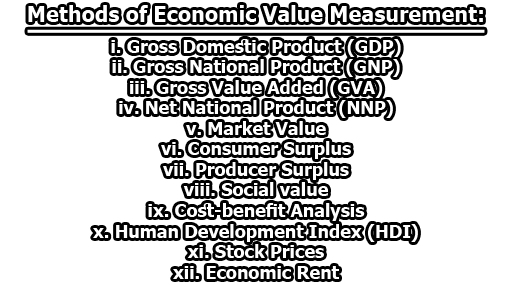Economic value refers to the worth of a good or service as determined by its utility or usefulness in satisfying the needs or wants of individuals or society as a whole. Economic value can be subjective, as it depends on individual preferences and the context in which a good or service is consumed. In the rest of this article, we are going to know about methods of economic value measurement, the economic value of consumer goods, and economic value in marketing.
Definitions of Economic Value:
Some of the definitions of Economic Value are given below:
In economics, economic value is the value of an asset, good, or service, determined by the market demand for it, which can be measured by the amount willing to be paid for it. The economic value of an asset or product is determined by supply and demand, which can be influenced by a variety of factors such as scarcity, quality, and the availability of substitutes. (Investopedia)
Economic value is a measure of the benefits that a good or service provides to an individual or society as a whole. It is typically measured in terms of the willingness of consumers to pay for the good or service and is influenced by factors such as scarcity, utility, and market conditions. (Encyclopedia Britannica)
Economic value is the value of a good or service based on the benefits it provides to consumers and the cost of producing it. It is determined by the market demand for the product and is influenced by factors such as the quality and availability of substitutes, changes in consumer preferences, and technological innovations. (Merriam-Webster)
Economic value is the value of a good or service in relation to its cost of production, including both direct costs such as materials and labor, as well as indirect costs such as overhead and marketing expenses. It is influenced by factors such as market demand, competition, and changes in technology or production methods. (The Balance)
Methods of Economic Value Measurement:
There are several methods of economic value measurement, depending on the context and purpose of the measurement. Some of them are the following:
i. Gross Domestic Product (GDP): GDP is the most widely used measure of economic activity and is the market value of all final goods and services produced within a country’s borders during a given period. It measures the total economic output of a country and includes consumer spending, government spending, investment, and net exports.
ii. Gross National Product (GNP): GNP is similar to GDP, but it includes the value of goods and services produced by a country’s citizens and companies, regardless of their location. This measure reflects the income earned by a country’s residents.
iii. Gross Value Added (GVA): GVA measures the value of goods and services produced by a firm or an industry, minus the cost of inputs such as raw materials and intermediate goods. This measure provides a more detailed picture of the contribution of individual sectors to the economy.
iv. Net National Product (NNP): NNP is similar to GNP, but it takes into account depreciation and other capital expenditures that reduce the value of a country’s assets over time.
v. Market value: This is the price a good or service fetches in a competitive market. Market value reflects the perceived value of the good or service by buyers and sellers in the market, as influenced by factors such as supply and demand, competition, and consumer preferences.
vi. Consumer Surplus: This is the difference between what a consumer is willing to pay for a good or service and what they actually pay. Consumer surplus reflects the additional benefit or utility that a consumer receives from a good or service beyond what they pay for it.
vii. Producer Surplus: This is the difference between the price a producer receives for a good or service and the minimum price they are willing to accept. Producer surplus reflects the additional benefit or profit that a producer receives from a good or service beyond the cost of producing it.
viii. Social value: This is the total value to society of a good or service, taking into account both the private benefits enjoyed by individuals and any externalities or spillover effects on others. Social value reflects the broader impact of a good or service on society as a whole, beyond its direct market value.
ix. Cost-benefit analysis: This is a method for comparing the costs and benefits of a project, policy, or investment to determine its overall economic value. The cost-benefit analysis takes into account the direct and indirect costs and benefits of a decision and can be used to assess the efficiency of different options.
x. Human Development Index (HDI): The HDI is a composite measure that takes into account a country’s economic, social, and human development indicators, including life expectancy, education, and income. It provides a broader picture of a country’s economic value beyond traditional economic indicators.
xi. Stock Prices: Stock prices reflect the market value of a company’s assets and future earning potential. They can be used as a measure of economic value, particularly for publicly traded companies.
xii. Economic Rent: Economic rent is the additional value that is earned by a resource (such as land or labor) due to its scarcity. It represents the excess value that is earned beyond what is required to maintain the resource.
Overall, the method used to measure economic value will depend on the context and purpose of the analysis.
Economic Value of Consumer Goods:
The economic value of consumer goods refers to the total value that consumers derive from the goods they purchase. This value is typically measured in terms of consumer surplus, which is the difference between the amount that consumers are willing to pay for a good or service and the actual price they pay.
Consumer surplus can be calculated by estimating the demand curve for a particular good or service. The demand curve shows how much consumers are willing to pay for different quantities of the good. The area below the demand curve and above the market price represents the consumer surplus.
Consumer goods that provide high levels of utility or satisfaction to consumers typically have a high economic value. For example, a luxury car that provides a high level of comfort, convenience, and status may have a high economic value, as consumers may be willing to pay a premium for these benefits.
Conversely, consumer goods that provide low levels of utility or satisfaction may have a low economic value. For example, a low-quality, generic brand of cereal may have a low economic value, as consumers may not be willing to pay much for a product that provides little satisfaction or nutritional value.
Ultimately, the economic value of consumer goods is determined by the interaction between consumer preferences and market prices. Consumers are willing to pay more for goods that provide higher levels of satisfaction, and market prices reflect the costs of production and distribution.
Economic Value in Marketing:
Economic value is an important concept in marketing, as it can help companies to understand how much customers are willing to pay for their products or services. By understanding the economic value of their products, companies can set prices that are attractive to customers and that also generate profits for the company.
One way that companies can measure economic value is by conducting customer research to understand the benefits that customers derive from their products or services. For example, a company that sells a fitness app may conduct customer surveys to understand the specific benefits that users are looking for, such as improved health or better fitness tracking. Based on this research, the company can set prices that reflect the value that customers place on these benefits.
Companies can also measure economic value by analyzing their competitors’ pricing strategies. By understanding the prices that competitors charge for similar products or services, a company can determine whether they are offering good value to customers. If a company’s prices are significantly higher than those of its competitors, it may need to offer additional benefits or features to justify the higher price.
Finally, companies can measure economic value by tracking customer behavior over time. By analyzing sales data and other metrics, companies can determine how customers are responding to changes in prices, promotions, or other marketing efforts. This information can help companies to refine their pricing strategies and to maximize the value that they offer to customers.
Overall, understanding the economic value of their products or services is a critical component of successful marketing for companies. By offering good value to customers, companies can build brand loyalty, increase customer retention, and generate long-term profits.

Library Lecturer at Nurul Amin Degree College










